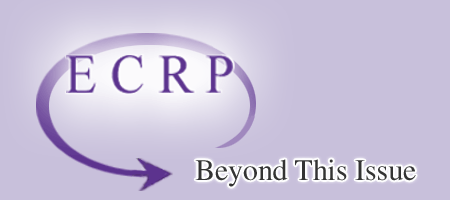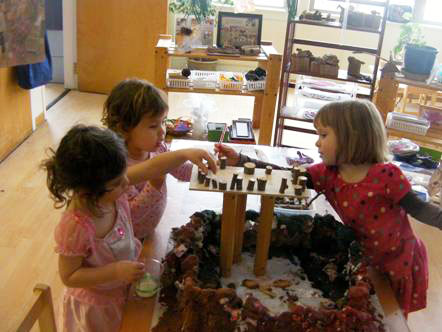SEED Papers: Published Fall 2010
What Professional Development in Early Childhood Science Will Meet the Requirements of Practicing Teachers?
Abstract
This essay addresses the question “What professional development in early childhood science will meet the requirements of practicing teachers?” in the context of the Boulder Journey School. The author discusses the influence of David and Frances Hawkins and educators from Reggio Emilia and distinguishes between “making a mess” and “messing about.” The author concludes by summarizing six ways that professional development can maximize the potential of early childhood science educators.
Boulder Journey School
The reflections that follow represent the evolution of the Boulder Journey School learning community’s thinking and actions surrounding the question “What professional development in early childhood science will meet the requirements of practicing teachers?”
To adequately address this question, I will begin with the origin of the school. Boulder Journey School began in 1984 as a weekly one-hour “mommy and me” class, part of the Boulder Valley School District Life Long Learning Program. The class, “Make a Mess and Make Believe,” offered nine children and their parents—at that time almost exclusively mothers—an opportunity to engage in arts-and-crafts activities that many parents deemed too messy for home. Classes also offered “stay at home mothers” a place to meet other mothers with young children. A central idea—maintained from our inception through our growth and development into Boulder Journey School, a year-round, full-day school of 250 children and their families, and through the school’s introduction to the world-renowned schools for young children in Reggio Emilia, Italy—is that children have the right to explore and discover the world using all of their senses, even if that means making a mess.
Although this tenet holds true, we have come to understand that “making a mess” and “messing about” are not the same. This understanding began with two important introductions—the aforementioned introduction to the infant-toddler centers and preschools in Reggio Emilia in 1995 and, as a result of this introduction, our introduction to David and Frances Hawkins that same year.
Reggio Emilia Educators and David and Frances Hawkins
At this juncture, a contextual digression is necessary. Educators in Reggio Emilia and educators around the world who are inspired by the educational philosophy and pedagogy of the schools in Reggio Emilia, including educators at Boulder Journey School, hold an image of children as curious, competent, and capable—children who are able to co-construct knowledge through their relationships with others, both children and adults, and through their relationships with their environment. The image of a competent child exists in tandem with an image of a competent teacher, who supports, encourages, deepens, and extends the child’s physical and social research (Rinaldi, 2006). Many of the ideas inherent in what is named “The Reggio Emilia Approach to Early Childhood Education,” including the images of capable children and educators, draw inspiration from the work of both classic and contemporary philosophers, including David Hawkins. Loris Malaguzzi (1998), architect of the philosophy and pedagogy of the schools in Reggio Emilia, cites Hawkins’ writing as among the most influential. Hawkins visited Reggio Emilia on two occasions—in 1990 for the first international conference and in 1992, with Frances Hawkins, to visit the schools. Lella Gandini (2008) writes of the relationship between Hawkins and Malaguzzi as a meeting of two minds who held a shared vision of children.
David Hawkins, whose areas of expertise spanned myriad domains—including the physical, social, and political sciences; mathematics; philosophy; and economics—and Frances Hawkins, early childhood teacher, author, and consultant, proffered their vast knowledge and experience to educators not only in Italy and the United States but also in England, New Zealand, Nigeria, Kenya, and Uganda. The notion of the capacity of children and their teachers to learn and to teach is woven through a plethora of projects they inspired, nurtured, and brought to fruition.
Returning to the tension surrounding making a mess as contrasted to messing about, David Hawkins (2002), in his seminal essay “Messing about in Science,” speaks of this phase of learning as a time devoted to unguided exploratory work, during which children “construct, test, probe, and experiment without superimposed questions or instructions” (p. 68). Inherent in that idea is that the teacher carefully prepares the environment, offering the children materials and equipment with which to engage. The teacher’s preparation of the environment is based on her knowledge of the children’s backgrounds and interests, combined with an understanding of children’s learning, motivation, and development. This structure, based on the teacher’s knowledge and understanding, which Hawkins deems “of the utmost importance” (p. 69), defines messing about in contrast to making a mess. Note—“Intention” is the differentiator. Children who are making a mess may indeed be joyful, but the experience lacks intention beyond mess making. Children who are messing about may also be joyful, but they bring intentionality to the experience, an experience of meaning making. The teacher recognizes the children’s intentions and contributes her own intentions to the preparation of the learning environment.
Messing about is also differentiated from making a mess: as the children engage in explorations and investigations, the teacher’s role is to closely observe, document, revisit, and interpret the work of the children, together with families, colleagues, and the children themselves. The process of studying children’s thinking and learning through observation, documentation, and interpretation is foundational to the work in Reggio Emilia and has been translated within the Boulder Journey School context. Malaguzzi (1998) writes, “Stand aside for a while and leave room for learning, observe carefully what children do, and then, if you have understood well, perhaps teaching will be different from before” (p. 82).
Hawkins (2000) provides a more pragmatic example that further defines the teacher’s role as described by Malaguzzi. In the essay titled “What It Means to Teach,” Hawkins refers to a film from Cornell University in which a series of kindergarten children spontaneously come to a table to play with an equal-arm balance and a large number of washers and other weights. He notes that in watching the film, one begins to recognize in oneself the ability to read the levels and specialized interests represented by the children—assuming that one is personally familiar with the large variety of balance situations that are possible and with some of the underlying ideas surrounding the study of balance. What one finds oneself doing is building what Hawkins calls a map of each child’s mind and of the trajectory of each child’s life. This map of the mind is fragmentary, fallible, and always subject to correction. As the teacher-observer, one begins thinking about how to steady, extend, and deepen the engagement that the child has begun.
We have learned from the educators in Reggio Emilia that the process of observation, documentation, and interpretation is subjective. The teacher—in the most advantageous situations along with colleagues and families—makes choices about what to observe and how she will gather her observations as documentation. Further, she bases her observations, documentations, and interpretations on her hypotheses and theories about children’s meaning making, which will, through the process, be refuted or confirmed. This requires that the teacher become aware of her own evolving knowledge and its structure. The teacher’s meta-cognition—her awareness of her knowing and her awareness of her knowing about her knowing—not only supports the child’s meta-cognition but also serves as a means of continuous and permanent professional development (Rinaldi, 2006; D. Dumont, personal communication, April 3, 2010).
The learning-teaching relationship among the children and their teacher is reciprocal—while the children are learning about the physical and social world, the teacher is learning about the children’s processes of learning. This supports the children’s learning about their world and so forth. The teacher offers her learning about children’s learning processes to the teaching-learning relationship. However, Hawkins (1997) discusses another aspect of the teacher’s offering that is critical and, thus, must be seriously considered in a second seminal essay titled “I, Thou, and It”:
An environment of “loving” adults who are themselves alienated from the world around them is an educational vacuum. Adults involved in the world of man and nature bring that world with them to children, bounded and made safe to be sure, but not thereby losing its richness and promise of novelty. It was this emphasis, which made me insist upon the third pronoun in the title, the impersonal “It” alongside the “I” and “Thou.” Adults and children, like adults with each other, can associate well only in worthy interests and pursuits, only through a community of subject matter and engagement which extends beyond the circle of their intimacy. (p. 350)
An important area of inquiry at Boulder Journey School is professional development, designed to facilitate teachers’ learning about the physical and social world, together with learning about children’s learning processes and relationships within a school community.
Professional Development and the Hawkins Room for Messing About with Materials and Ideas
Another contextual digression is necessary. Although David and Frances Hawkins were longtime Boulder neighbors, educators at Boulder Journey School met them as a result of our study of the schools in Reggio Emilia. From the beginning of this study, it was apparent that there is a great deal of the synergy between David and Frances Hawkins and Reggio Emilia. Yet it was not until 2004, with the creation of Hawkins Centers of Learning (http://www.hawkinscentersoflearning.org) and the donation of boxes of materials by the Hawkins family to this nascent organization, that we came to realize the deep influence of the Hawkins’ thinking on the work of Malaguzzi and his colleagues in Reggio Emilia and on noted educators and educational initiatives worldwide.
Summaries of the resources and activities of the Hawkins-founded Mountain View Center for Environmental Education and articles in the journal Outlook written by Mountain View staff and published by the Center underscore the importance of the teacher’s exploration of materials, alongside children and peers. This understanding encouraged educators at Boulder Journey School, supported by Hawkins Centers of Learning, to create the first “Hawkins Room for Messing About with Materials and Ideas” as an adult studio and action think tank. The room is central to the relatedness of child/adult learning and knowing. Areas of adult investigation emanate directly from the daily work of children and adults in the school and also contribute to the evolution of this work. Several examples of this continuum, which is by no means linear, follow.
Rolling
Within one of the many boxes of materials donated to Hawkins Centers of Learning by the Hawkins family was a book published in 1973 for the African Elementary Science Project titled Activities for Lower Primary—Wheels, which inspired Boulder Journey School teachers’ exploration of rolling in the Hawkins Room (see Figure 1). As a faculty, we were seeking to better support the children’s interest in rolling through our own investigations. We filled the room’s shelves with recycled materials, adhesives, wire, ropes, measuring tapes, wood pieces, and cardboard, and we began to create cars. After building and field-testing many cars, we invited a small group of children to comment on our work. The children wondered why we built cars, many of which did not roll very far or very fast and others that did not roll at all. In their work, parallel to ours, the children were categorizing objects by their ability to roll fast and far, referred to by the children as “rollability.” While the teachers were immediately immersed in the theme of transportation, the children taught us that the work was about the concepts inherent in rolling, such as velocity, acceleration, distance, time, and friction. The initial work on rolling has led to schoolwide investigations of incline, both existing and constructed, and of a related concept, chain reaction (see Figure 2).
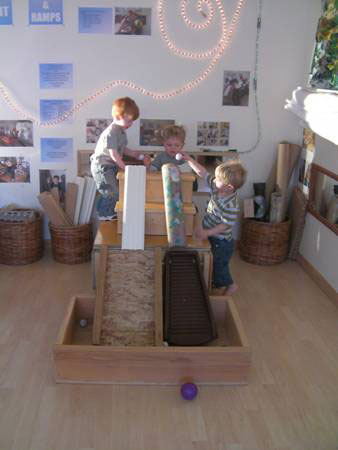
Figure 1. Two-year-old children experiment with incline.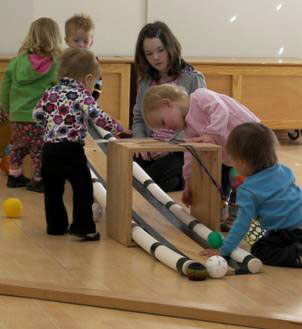
Figure 2. Eighteen-month-old children seek ways to ring a bell with a ball.
Balance
Concepts basic to our understanding of balance are woven through our everyday encounters with the world. Young children learning to walk and climb are constantly grappling with these concepts. This provided an incentive for exploring balance in the Hawkins Room for Messing About with Materials and Ideas (see Figure 3). Provocations related to balance, introduced by science education consultant Dr. Barry Kluger-Bell (Mountain View Center staff, 1971-1978), have increased awareness by faculty of the complex science and mathematical concepts inherent in our study of balance—weight, distance, slope, friction, angle, and center of gravity. Realizing the knowledge that children gain from experiences with balance has inspired us to offer provocations connected to children’s experiences in the natural world. For example, an excerpt from one toddler classroom’s daily journal reads: “Outside, we noticed the children playing with the concept of balance using their bodies. As an extension, we presented a challenge to the children… Can you build and balance pieces of wood on a rock?” (C. Spencer, journal entry, 2010).
Figure 3. Three-year-old children balance wooden chairs atop a castle’s lookout tower.
Drawing
Analyses of samples of children’s drawings over a period of four years revealed a common thread: By the time children were 4 or 5 years of age, they had developed symbols for certain objects, such as houses, flowers, and butterflies. They repeatedly drew these symbols, even when encouraged by teachers to elaborate. This observation, in combination with others that elicited teachers’ questions, indicated that, as a faculty, we needed to increase our knowledge about drawing in order to effectively scaffold the children’s expression of their ideas using drawing as a language. In the Hawkins Room for Messing About with Materials and Ideas, we introduced provocations for drawing: a variety of pencils, erasers, paper, 2- and 3-dimensional objects to draw, mirrors for self-portraits, and several references, including the book Drawing on the Right Side of the Brain (Edwards, 1989). Teachers read and shared ideas, while exploring the language of drawing. Insights gleaned from small groups of teachers working in the Hawkins Room and shared with the entire faculty inspired teachers to invite children to draw in new ways (Figure 4)—to draw objects in relation to other objects, considering the mathematics of size and scale (e.g., a princess who must fit into her castle); to draw objects from multiple perspectives, considering the engineering required to illustrate three dimensions in two (e.g., a shark swimming in the ocean versus a shark mask); to draw objects in motion, considering the physics of a moving object (e.g., a bending knee, a waving arm, a twirling body).
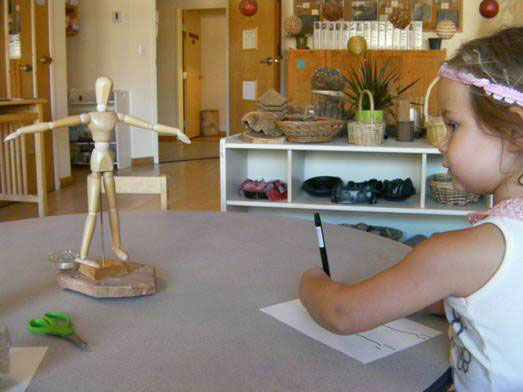
Figure 4. A 3-year-old child draws the human figure, using a mannequin as a reference.
Synthesis
As our reflections on the question addressed by this paper continue to evolve, rather than a conclusion, I prefer to pause, synthesize, and summarize our thinking. What professional development in early childhood science will meet the requirements of practicing teachers?
To maximize the potential of early childhood science educators, professional development must…
- Be ongoing. To quote David Hawkins (2000), “It may be possible to learn in two or three years the kind of practice that then leads to another continued forty years of learning. Whether many of our colleges get many of their students on to that fascinating track, or whether the schools are geared to a thoughtful support of such endless learning by their teachers, is another matter. To understand the dimensions of the teaching art, complex and inexhaustible though it be, is an equally endless commitment and one that needs constant insight and renewal” (p. 41).
- Recognize and respect the desire of children and adults to co-construct knowledge about the physical and social world.
- Provide space to mess about with materials and time to engage in a sharing of ideas with other adults.
- Be closely connected to ongoing investigations in the school that are observed, documented, and analyzed.
- Utilize resources from the scientific community and from the political, economic, and cultural communities.
- Provide a forum through which teachers are able to gain competency as well as the feeling of competency—the empowerment and enthusiasm that is necessary to venture into a place of authentic inquiry with children and other adults.
References
Edwards, Betty. (1989). Drawing on the right side of the brain: A course in enhancing creativity and artistic confidence. Los Angeles: J.P. Tarcher.
Gandini, Lella. (2008). Meeting of minds: Malaguzzi and Hawkins. In Lella Gandini, Susan Etheredge, & Lynn Hill (Eds.), Insights and inspirations from Reggio Emilia: Stories of teachers and children from North America (pp. 36-37). Worcester, MA: Davis Publications.
Gornall, F. A. (1973). Activities for lower primary—wheels. Boulder: Mountain View Center for Environmental Education, University of Colorado. Retrieved September 22, 2010, from http://hawkinscentersoflearning.org/Resources.html
Hawkins, David. (1997). Afterword. In Frances P. Lothrop Hawkins, Journey with children: The autobiography of a teacher (pp. 349-350). Niwot: University Press of Colorado.
Hawkins, David. (2000). The roots of literacy. Boulder: University Press of Colorado.
Hawkins, David. (2002). The informed vision: Essays on learning and human nature. New York: Algora Publishing.
Malaguzzi, Loris. (1998). History, ideas, and basic philosophy: An interview with Lella Gandini. In Carolyn Edwards, Lella Gandini, & George Forman (Eds.), The hundred languages of children: The Reggio Emilia approach—Advanced reflections(2nd ed., pp. 49-97). Greenwich, CT: Ablex.
Rinaldi, Carlina. (2006). In dialogue with Reggio Emilia: Listening, researching, and learning. London: Routledge.
Author Contact Information
Dr. Ellen HallBoulder Journey School
1919 Yarmouth Avenue
Boulder, CO 80304
Email: ellen.lynn.hall@gmail.com
